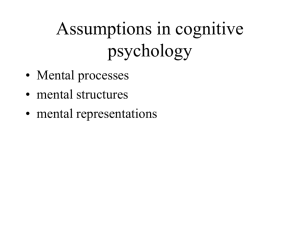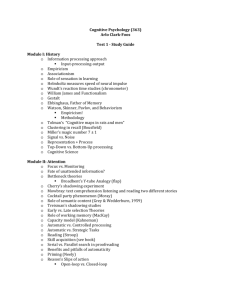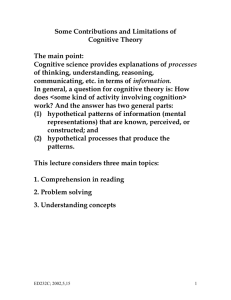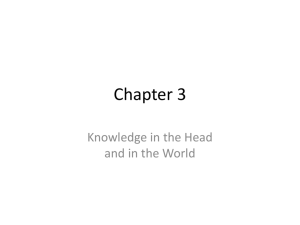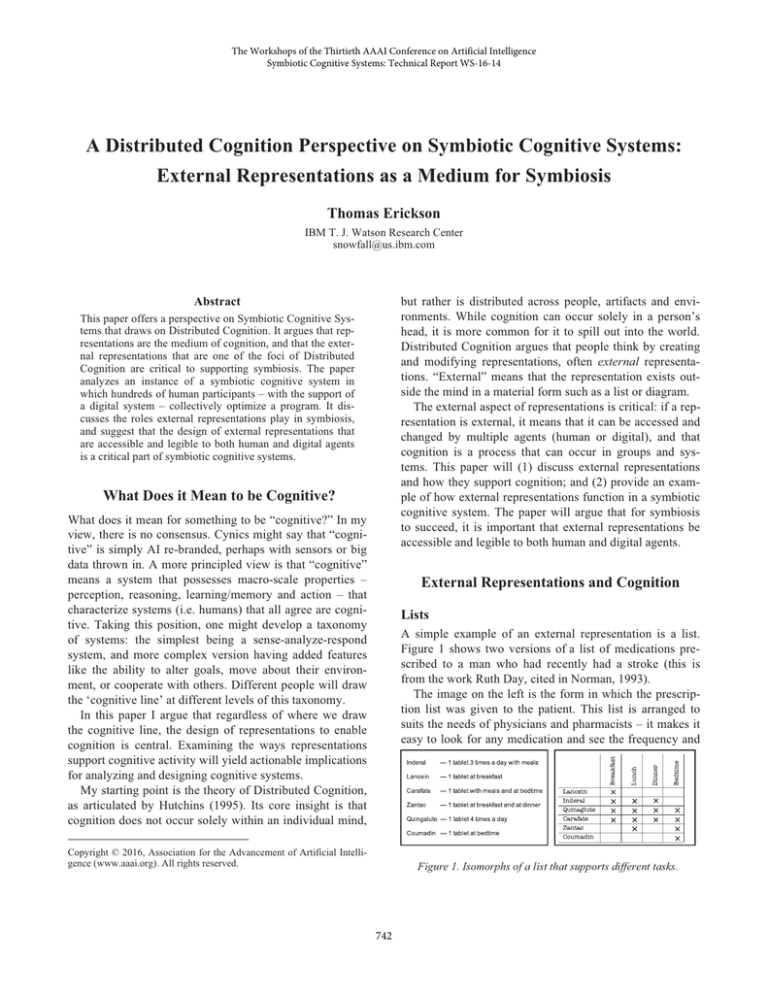
The Workshops of the Thirtieth AAAI Conference on Artificial Intelligence
Symbiotic Cognitive Systems: Technical Report WS-16-14
A Distributed Cognition Perspective on Symbiotic Cognitive Systems:
External Representations as a Medium for Symbiosis
Thomas Erickson
IBM T. J. Watson Research Center
snowfall@us.ibm.com
Abstract
but rather is distributed across people, artifacts and environments. While cognition can occur solely in a person’s
head, it is more common for it to spill out into the world.
Distributed Cognition argues that people think by creating
and modifying representations, often external representations. “External” means that the representation exists outside the mind in a material form such as a list or diagram.
The external aspect of representations is critical: if a representation is external, it means that it can be accessed and
changed by multiple agents (human or digital), and that
cognition is a process that can occur in groups and systems. This paper will (1) discuss external representations
and how they support cognition; and (2) provide an example of how external representations function in a symbiotic
cognitive system. The paper will argue that for symbiosis
to succeed, it is important that external representations be
accessible and legible to both human and digital agents.
This paper offers a perspective on Symbiotic Cognitive Systems that draws on Distributed Cognition. It argues that representations are the medium of cognition, and that the external representations that are one of the foci of Distributed
Cognition are critical to supporting symbiosis. The paper
analyzes an instance of a symbiotic cognitive system in
which hundreds of human participants – with the support of
a digital system – collectively optimize a program. It discusses the roles external representations play in symbiosis,
and suggest that the design of external representations that
are accessible and legible to both human and digital agents
is a critical part of symbiotic cognitive systems.
What Does it Mean to be Cognitive?
What does it mean for something to be “cognitive?” In my
view, there is no consensus. Cynics might say that “cognitive” is simply AI re-branded, perhaps with sensors or big
data thrown in. A more principled view is that “cognitive”
means a system that possesses macro-scale properties –
perception, reasoning, learning/memory and action – that
characterize systems (i.e. humans) that all agree are cognitive. Taking this position, one might develop a taxonomy
of systems: the simplest being a sense-analyze-respond
system, and more complex version having added features
like the ability to alter goals, move about their environment, or cooperate with others. Different people will draw
the ‘cognitive line’ at different levels of this taxonomy.
In this paper I argue that regardless of where we draw
the cognitive line, the design of representations to enable
cognition is central. Examining the ways representations
support cognitive activity will yield actionable implications
for analyzing and designing cognitive systems.
My starting point is the theory of Distributed Cognition,
as articulated by Hutchins (1995). Its core insight is that
cognition does not occur solely within an individual mind,
External Representations and Cognition
Lists
A simple example of an external representation is a list.
Figure 1 shows two versions of a list of medications prescribed to a man who had recently had a stroke (this is
from the work Ruth Day, cited in Norman, 1993).
The image on the left is the form in which the prescription list was given to the patient. This list is arranged to
suits the needs of physicians and pharmacists – it makes it
easy to look for any medication and see the frequency and
Copyright © 2016, Association for the Advancement of Artificial Intelligence (www.aaai.org). All rights reserved.
Figure 1. Isomorphs of a list that supports different tasks.
742
tions are used to support symbiotic cognition. The example
to be considered is an online “contest” in which hundreds
of human agents and one (or more, depending on how one
counts) digital agents, collectively optimize a program.
In late 1998 a company called The Mathworks began
holding online programming contests to promote its programming language, MATLAB. The contest worked as
follows. A problem was proposed – for instance, guide 5
Mars Surveyor robots in exploring a map of passable and
impassable regions – and contestants would write programs to solve it. Upon submission, each contestant’s program was automatically scored, the score reflecting two
factors: (1) quality – percent of territory explored by surveyors; and (2) performance – the CPU time required.
Once scored, the results were posted on a Standings Page
(Figure 2) that ranked all submissions by their scores, identified the authors, and disclosed both the quality and performance metrics that went into each score.
What makes this contest of particular interest is that it
was ‘open source:’ once a submission was scored and
posted on the Standings Page, a single click revealed the
entry’s code. This enabled the practice of “tweaking.” For
instance, contestant A might devise a new algorithm for
solving a problem that vaulted her into first place, but a
few minutes later contestant B might examine her code,
replace a single statement with a more efficient version,
and take over first place due to slightly better performance.
Just as tweaking was quick and easy for B, so would it be
for C, D and E, and thus B’s first place status was generally short lived. The Standings Page showed a lot of churn.
Tweaking was controversial, as Ned Gulley describes in
his account of the contest (Gulley, 2005). Many participants were ambivalent – they did it, but felt bad about it.
This is visible in the names of entries like “ripoff,” “outright theft,” and “If All Else Fails, TWEAK!” Others were
less apologetic, with chiding names like: “Brackets are
Expensive.” Others paid homage to their ancestors: an entry named Soup Dragon, whose descendants were tweaked
into ascendency for a time, generated offspring with names
like “SoupMix,” “SneakyGreenSoup,” and the ultimate
timing with which it was prescribed. However, a problem
with the list on the left is that it is not very easy for an ordinary person (let alone a stroke victim) to use. It does not
make it easy to answer practical questions like: “It’s breakfast time, what do I take now?” or “I’m leaving the house
at 10am, and won’t be home until 9pm, how many of each
pill should I bring with me?”
The image on the right (Figure 1) shows an isomorphic
version of the list: the content is the same, but the layout
was designed with the patient’s questions in mind: one can
see, at a glance, which medications need to be taken when.
The point is not that one version of the list is better than
another, but that the versions are designed to support different cognitive tasks. In a paper-based world it is not a
bad idea to standardize on one form of representation; but
in the digital world, where representations are mutable, it
makes sense to think about supporting multiple versions of
a representation so that it can easily support multiple tasks.
Other Representations
While, as representations go, lists are about as simple as
one can get, the point is generally true: the design of representations impacts the ease of performing cognitive tasks.
There is a nice set of examples of external representations
in Don Norman’s book, Things that Make Us Smart (Norman, 1993). They range from numeric symbols (Arabic vs.
Roman Numerals) to physical representations (the rings
and pegs of the classic “Tower of Hanoi” puzzle). The lesson is that, using metrics such as performance and error
frequencies, the design of representations matter. Two representations that are equivalent in their content may differ
in the degree to which they facilitate or inhibit the performance of various cognitive tasks.
Symbiotic Cognition: An Example
Thus far the discussion has focused on representations that
enable an individual to carry out a cognitive task. In this
section, I discuss an example in which external representa-
Figure 2. The Standings List serves as an external representation that supports collective program optimization in the MatLab contest.
743
The External Representations and their Roles
winner, “NoSoup4U!” As Gulley notes, in spite of the ambivalence, “tweaking turns out to be the fuel that drives the
entire contest. It offers an immediate reward to the tweaker
– for an investment of a few minutes, your name appears
on the leader board [Standings Page], wreathed in glory.
The practice is also a call to arms for the original author
(“How dare someone tweak my code!”). If you get
tweaked, you want to know about it. And you may work
very hard to tweak your way back into first place.”
Not only does tweaking engage contestants, but collectively it is a powerful optimization mechanism. Figure 3
shows an analysis of the second contest, focused on the
“Mars Surveyor” problem. The figure shows each submission as a dot, positioned as a function of its time stamp and
score, so that the lowest dot at any given time designates
the current first place entry. The dots connected by the line
show the gradual optimization of an instance of an algorithm. A general pattern, within and between contests, was
that promising new algorithms would be rapidly optimized
in crescendos of tweaking.
This is an excellent illustration of a large scale cognitive system composed of human and digital agents. Let’s
examine the role that external representations play.
The cognitive system – that is, the MatLab contest comprised of its human agents and digital infrastructure – consists of three external representations that enable human
agents to collectively optimize a program for solving a
particular problem. It is these representations – to which
both digital and human agents have access – that enable
collaboration among individuals (even though the ‘collaboration,’ being part of a contest, is not entirely voluntary).
There are three external representations in play: (1) the
Rules Page; (2) the Submissions; and (3) the Standings
List. The Rules Page is quite simple: it describes the problem to be solved, provides resources such as sample code,
test functions, a forum, and lays out the rules of the contest
– including making it clear that ‘tweaking’ is encouraged.
Basically, it provides what participants need to get started.
The other two external representations – the Submissions
and the Standings List – play more complex roles as described below.
The Set of Submissions Enables Integration
The Submissions – which we consider as a collective – is
the growing cloud of contest entries that solve the same
problem, many of which are tweaked versions of previous
submissions. The Submissions, in their entirety, capture
elements of the solution, and optimizations of its components. Because participants can download any submission,
they can analyze and modify it as they wish, and then upload the new version.
What is important is that this external representation enables tweaks to accumulate: A’s submission has a novel
algorithm; B downloads and tweaks A’s code to make it
faster and resubmits it; C downloads and tweaks B’s code
and resubmits that, and so on…
But why does B decide to tweak A’s submission in particular? There may have been 100 submissions since B last
visited. And why did C focus on B’s code rather than any
of hundreds of other submissions?
The Standings List Enables Cognitive Focus
A critical feature of the contest is that the cloud of program
instances is not simply used by human agents, it is accessible to the digital elements of the system. That’s important
because, loosely speaking, the system understands the
Submissions: it is able to run each submission and give it a
score, and position it in the Standings List. And it is the
Standings List that enables participants to decide where to
focus their attention in the Submissions. Most attention will
likely be focused on the current leader, but it is also the
case that certain authors (whose names are listed in the
Standings List) or certain approaches (which are both associated with authors and often signaled in the submissions’
Figure 3. Collective optimization of contest entries through
repeated ‘tweaks’ by multiple participants. The dots
connected by the line show the appearance of a
novel algorithm that is repeatedly tweaked.
(The Mathworks, 2015)
744
Conclusion and Proposal
names) may develop followings. Whatever the case, the
Standings List enables B to find A’s submission, and C to
find B’s. In short, the Standings List provides an index into
the ever-growing cloud of Submissions.
This position paper argues that the design of external representations is central to symbiotic cognitive systems.
First, it has noted that different but isomorphic forms of a
representation can make a particular cognitive task easier
or more difficult. Second, it has analyzed a large-scale distributed cognitive system in which hundreds of participants, without explicitly cooperating, collectively optimize
programmatic solutions to complex problems. The analysis
shows how two external representations – the Set of All
Submissions, and the Standings List – enable a system that
incents individual agents to make ‘tweaks’ to a program,
permits individuals to focus on the particular submissions
that interest them so they may be tweaked, and thus allows
integration of optimizations over time and across participants.
While there has been considerable focus on how representations – whether used by digital or human agents – can
increase the efficiency with which a computational system
can solve problems, less attention has been given to how
external representations play other roles. In particular, with
a focus on symbiosis, I think it could be useful for the
workshop to try to think through some of the ways in
which external representations might support symbiotic
activity. The MatLab contest illustrates how external representations can support integration, attention, and incentives; doubtless there are other ways in which external representations can serve these ends. Furthermore, there are
no doubt other activities necessary to symbiotic cognition –
planning, ranking and selection, achievement of consensus,
generation of variations on a concept, generalization, supporting cooperation among agents, impedance matching
between human and digital agents, and so on – that external representations can support.
I am not sure of the best way for the workshop to proceed were we to pursue this path, but I think a focus on
representation would allow all participants — regardless of
where they draw the cognitive line, and what they view as
a cognitive system – to contribute to a symbiotic result.
The Standings List Enables Incentive Mechanisms
The Standings List plays a second role as well. It serves as
an incentive mechanism. Because this large-scale computation is dependent on humans to function, the system needs
to encourage participation. There are many approaches to
this, but in this case the activity has been framed as a “contest.” That means it has “winners” and “losers,” that “competition” is expected, that the “contest” has a “start” and an
“end,” that there is often a burst of effort as the end nears,
and on and on. It is this framing, and its explicit support
via the Standings List, that provides the motive power for
the collective interaction. And at the same time, it is this
framing, and specifically contest-linked values having to
do with fairness and cheating, that makes contestants ambivalent about tweaking, even though it is explicitly encouraged in the rules. The ability to design and operate the
MatLab contest in a way that simultaneously tapped the
incentive power of the contest framing even as it positioned tweaking as “OK” rather than cheating, is what
makes this an artful example of symbiotic cognitive systems design.
Summary: A Symbiotic Cognitive System
In the MatLab contest, participants submit programs that
solve a complex problem. Upon submission, programs are
digitally evaluated for their speed and quality, and they
(and their authors) are positioned appropriately in the public Standings List. Because submissions can be downloaded, modified and resubmitted by other participants, the
contest encourages tweaks: small changes that make a program better and thus enable the tweaker to beat the original
submitter in the Standings List. Multiplied across contestants and algorithms, this collective tweaking proves to be a
powerful form of optimization.
I argue that the MatLab contest is a good example of a
symbiotic cognitive system. Each instance of the contest is
a ‘run’ of the system, and produces an optimized program
that solves a complex problem. While this cognitive system is admittedly human-centric, note that it would be impossible without the digital evaluation and maintenance of
its external representations, the Set of All Submissions and
the Standings List.
Finally, note that other human-centric symbiotic systems
are amendable to similar analyses, and offer more roles for
digital agents (e.g., Wikipedia with its various bots for
countering vandalism, tagging, and validation).
References
Gulley, N. 2004. In Praise of Tweaking. Interactions, 11:3: 18–
23.
Hutchins, E. 1995. Cognition in the Wild. Cambridge, MA: MIT
Press.
Norman, D. 1993. Things that Make Us Smart. Reading, MA:
Addison-Wesley.
The Mathworks. The Mathworks Mars Surveyor Contest Blog:
http://www.mathworks.com/matlabcentral/contest/contests/4/stati
stics.html. Accessed 21-October-2015.
745

